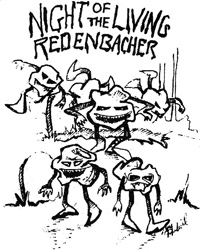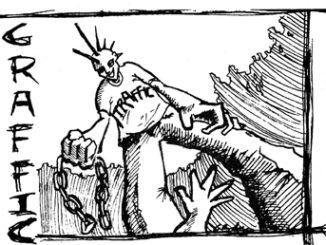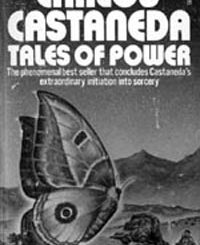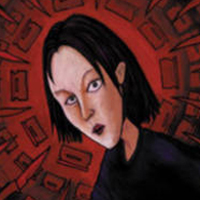 Night of the Living Reddenbachers
Night of the Living Reddenbachers
by Kerry Joyce
illustration by Greg Prindeville
Pop, pop pop, plunked the rain against my picture window, as it had since mid-morning. Pouring coffee, I looked gratefully out on the well-groomed grounds of my next door neighbor, the Gate Of Heaven Cemetery. No false advertising there. They only promised to get you to the gate, the rest was up to you.
In fact, the cemetery was the best neighbor imaginable. No dogs shitting on your lawn, no loud stereos, lawn mowers, or squealing tires. Just long rows of dead folk, a grim reminder of everyone’s eventual end, a reminder that made my house a lot more affordable than similar dwellings just a quarter mile down the street. “If it will save me $40,000 bucks, I’ll sleep with the dead,” I told the realtor, who laughed with a peculiar rattle, like only a realtor who just moved a house next to a cemetery can.
Things were always quiet, nearly. There was a little bit of noise when it turned out that Orville Reddenbacher, the bio-chemist/popcorn magnate, died. Orville was a regular Gregor Mendel, one who had successfully developed new strains of popping corn, which made him a fortune, and his likeness a fixture in every supermarket and convenience store in the world.
It was, I admit, a little bit exciting watching the Reddenbacher clan, red-eyed and richer, lower the brilliant but eccentric Orville into the ground.
He had this huge house in Glenview with a four car garage, converted into a workshop or laboratory of some kind. “He was busy right up until the day he died,” his wife told the local newspaper. “You couldn’t slow him down. He was always heating or freezing something out in the garage.”
Orville had even designed his own casket. It was reportedly made from an enzyme-treated peat moss, intended to achieve “complete biodegradation” by the first day of Spring. From my window, it looked more like baked enamel. “He always loved recycling,” his son was overheard explaining to a distant aunt. Anyway, special seeds were planted in the fresh Earth over his coffin, with these strange electrical contacts. The seeds would theoretically grow faster, and heartier, due to the incredible fertilizing effects of his last great invention.
Looking up occasionally, I thought I could still hear the raindrops pelting my window at dusk as I watched cold sunbeams stream into my parlor. Night fell and crickets chirped above the din, while I concentrated on my reading – a rare and curious volume of obscure facts about 19th century American Vice Presidents. An eerie chaos seemed to overtake the nighttime darkness.
I could say, ’twas then I heard a rapping on my chamber door. But actually it was the doorbell from the side entrance. I went out, and to my utter distraction, there was Orville Reddenbacher himself. He had no shoes, but what a suit. It was strangely bulky, but I worked in a clothing store once, and I know quality. About my size too.
“My name is Orville Reddenbacher and I’ve done it. I have conquered death,” he bragged with maniacal grandeur, between fits of coughing. His hair was mussed, but he looked closer to 58 than his reported 88 years. I tried to conceal my nervousness, and avoided his eyes, which gleamed with derangement through thick, prescription lenses.
“Would you like, some popcorn,” I sputtered. “It’s only Jiffy Pop, but it was on sale and I didn’t have clean pots.
“That’s perfectly fine, young man, I’d appreciate any nourishment you might have, though what I would really love is a Happy Meal. I dreamt of nothing else for what seemed an eternity. But there is plenty of time for that now.”
Between sips of water, Orville explained the engineering design of his casket. It had been turbo-charged with a quantity of microwave popcorn sufficient to gently heave off the freshly turned earth above it. He then went on about the incredible metabolic similarities between animal life and popcorn when first heated to 424 degrees centigrade then frozen at 64 degrees below zero, then reheated to 424 degrees again. I think. I can’t remember it all. It was pretty complicated and besides, I kept looking at his watch. It was one of those Rolex Presidentials with a diamond dial. I used to work in a jewelry store, so I know something like that goes for well over ten grand. It was pretty cocky, having yourself planted with a watch like that.
“You’ll be famous, again. Your face will be on ever coffin in the country. I used to work at a mortuary,” I said. I hadn’t really worked at a mortuary, but I was in one a couple of times and probably will be again. I feigned great interest in his technical outpouring, but I was actually studying the ring he had on his right pinky. It was a tiger’s eye blue sapphire. I knew a guy like Reddenbacher wouldn’t wear a synthetic. A stone like that was worth more than the watch. “Let’s call the newspapers,” I suggested.
“No, no, young man. We must keep this a secret. At least for a few years.” He then tearfully told me his plan to run off with a chamber maid he’d met in Lisbon at an international convention of corn-poppers. He had it all worked out. The lining of his suitcoat was stuffed to the gills with 50s and 100s – easily accessible with a thin zipper. There was about 75,000 bucks from the looks of it. Reddenbacher also had access to a secret trust fund worth millions. He felt guilty about leaving his family, but he had spent 88 years giving, giving, giving. It was time to live, live, live. It was all very exciting, very poignant, very sad.
“Let’s go for that Happy Meal,” I said, plunging a kitchen knife into his chest. The born again popcorn magnate fell against the counter and onto the floor. “There’s no law against killing a stiff,” he may or may not have heard me explain. You wouldn’t believe the mess. At least he wasn’t as heavy as that Amway guy I invited back to show me his baseball card collection. I used to work at a flea market, so I know how much some of those cards go for. And anyway, I don’t have a lot of problems with the neighbors.



